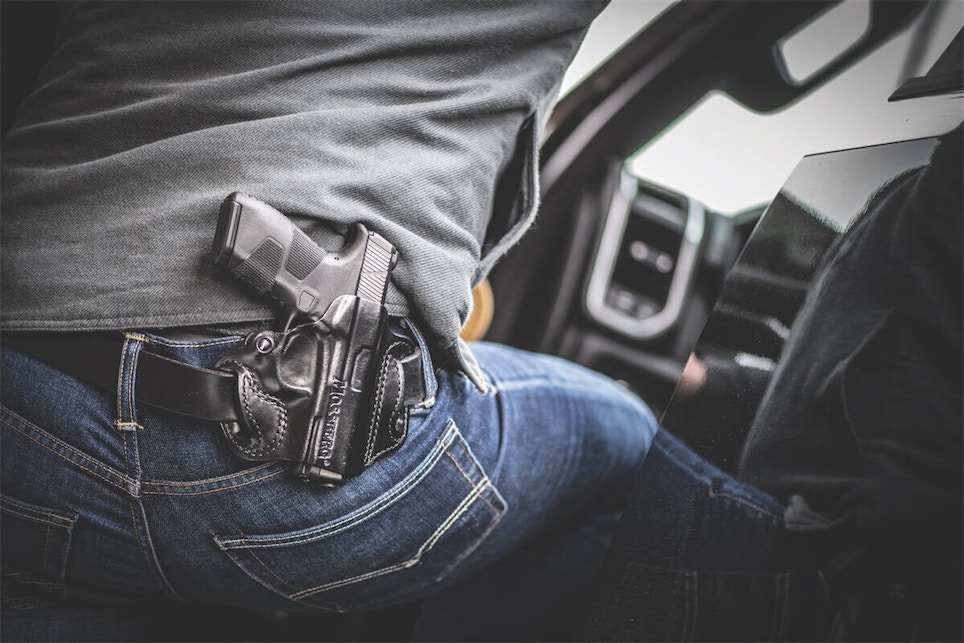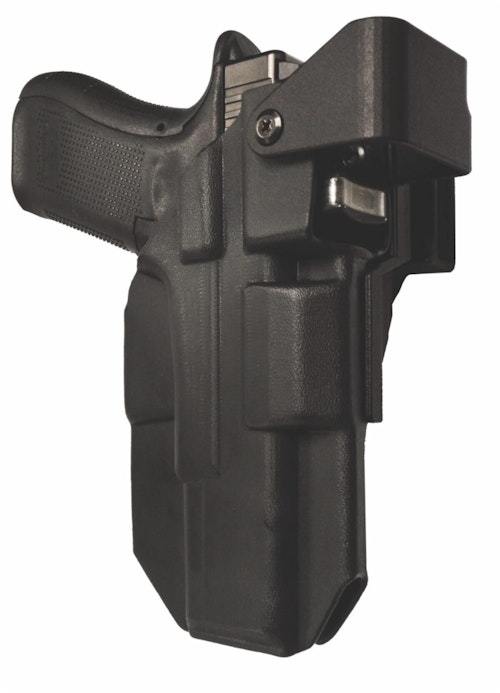If a customer purchases a handgun, take advantage of the opportunity to talk to them about a holster to go along with it. It’s one of the easier cross-sell opportunities in the shooting sports industry.
Something else to consider: Holsters can be significant aids in overall handgun safety. Moreover, with handguns purchased for concealed carry, hunting, or the range, each provides an opportunity to learn about your customer’s use and potentially cross-sell a holster to supplement that activity.
Holsters and Gun Safety
Holsters are not explicitly mentioned in the four traditional gun safety rules. But a few holster-related principles apply. Especially when you consider Rule 3. Let’s look at how they work together.
Rule 1: Treat every gun as if it were loaded. Follow this rule whether a handgun is in or out of a holster. Never leave a handgun in a place where it is accessible to an unauthorized user. Loaded or not, one of the better places for a handgun is in a holster on a competent and trained person, worn in such a way that only the carrier of the handgun, whom we will assume is an authorized user, remains in complete control of the handgun. A holstered handgun worn on a person helps ensure an unauthorized user will not be able to handle it, let alone fire it.
Rule 2: Never let the muzzle cover anything you are not willing to destroy. Follow this rule whether a handgun is in or out of a holster. But notice that a holstered handgun for the most part is pointing down at the ground, where it is generally OK to point a handgun until it is needed for something else. Some holsters leave the muzzle of a handgun exposed; others enclose the muzzle. A holster with an enclosed muzzle adds some element of safety as the holster design helps prevent things you don’t want to destroy (such as finger) from getting too close to a muzzle. Granted, a layer of leather or plastic won’t do much to stop a bullet, but at least there’s something there to help. Some holsters, such as shoulder holsters, carry some handguns horizontally. So, even while the handgun is holstered, trigger covered, access to unauthorized persons mostly denied, the muzzle is still pointing behind the person carrying the gun, sweeping over or covering who knows what.
Rule 3: Keep your finger off the trigger until your sights are on the target. Follow this rule whether a handgun is in or out of a holster. But notice the holster’s role in creating an extra barrier between triggers and fingers. This is where a holster can add an additional layer of safety. A proper holster with a handgun properly in the holster will not allow a finger — or, for that matter, any finger-like object — to get to the trigger in a way that could result in discharge.
With regard to trigger safety, notice the difference between hard and soft holsters, regardless of the material from which they are made. Any holster that allows a finger or other outside object to get into or press into the holster material from the outside in a way which allows the possibility of touching the trigger may not be safe.
When drawing a handgun from a holster, make sure the handgun comes out and the holster stays put. And when the handgun is in the holster, make sure the handgun is securely in the holster, unable to come out unless the wearer wants it to come out. This is where retention — by friction, strap, etc. — comes into play.
Be sure the holster adequately covers the trigger and trigger area. A holster should not allow a finger or any other object to access the trigger area of a handgun.
Rule 4: Know your target, what’s in front of it, and what’s behind it. Follow this rule whether a handgun is in or out of a holster. But especially when you’ve decided to draw your handgun from your holster while following all the other rules.
And if the situation requires re-holstering the handgun, know the limitations of the holster and what’s required to get the gun back in. Some holsters come with a reinforced mouth that keeps the holster open, making it easier to reholster the handgun. Other less rigid holster mouths may close or fold, making reholstering more difficult.
Other rules and ideas exist for how the gun safety rules apply when using holsters. The point is to appreciate and be ready to discuss these with your customers as they go through the process of purchasing a handgun. For the sake of safety and a dozen other reasons, a holster should be a simultaneous purchase.
In addition to how holsters may supplement handgun safety, handgun holsters exist for virtually every handgun carrying activity out there, including concealed carry, hunting and the range.
Concealed Carry
Arguably the most popular reason for holstering a handgun, the number of people carrying concealed handguns for self-defense has increased exponentially in recent years. Holsters offer carry options for right- and left-handers who want to carry inside the waistband or outside the waistband and in a variety of locations on their waist. Holsters exist for pocket carry and ankle carry and shoulder rigs offer Miami Vice-style carry. Other holsters are built into clothing, zippered binders, or make use of clips, magnets and other clever mounts.
In reality, your concealed handgun carrying customer may eventually need a variety of holsters to accommodate a variety of carry options. But the best way to complement a handgun purchase without overwhelming the customer is to help him or her think through what is the one or maybe two holsters to buy along with the gun. Here’s where a simple solution (such as an inside the waistband holster that clips to a gun belt) may be the most versatile solution, able to be worn in a variety of conditions and settings. Another viable cross-sell possibility is a gun belt.
Hunting
Holstering a handgun for hunting can take a couple of routes. The first is where the handgun carried is the handgun that’s doing the shooting for game. The second is where the handgun carried is a secondary or backup to another weapon. In the first instance, holstering a handgun for hunting may mean carrying a very large, scoped revolver in a chest rig. In the second instance, the handgun may be carried in an outside the waistband holster, more out of the way.
In either case, talk with your customer about how they’ll be carrying their handgun, the need to practice moving around with it and, of course, drawing. With handgun hunting, there may be need for a means to carry additional ammunition — the holster itself may provide a means for this via a pouch or bandolier.
Range/Target
Holstering a handgun for target shooting or the range may encompass a wide variety of holsters, so be sure to ask your customer about their usage and expectations. But also be prepared to help them know the rules about local ranges. Some ranges, for example, will not permit holstered handguns but instead require handguns to remain on the bench, actions open, when not in use. Or ranges may not allow drawing from a holster and firing (for safety reasons). In some cases, perhaps in a target practice scenario in a remote area, or perhaps in a controlled training environment, drawing from a holster may be permitted.
Appropriate holsters, then, may include thigh rigs that are essentially outside the waistband ‘drop’ holsters that carry a handgun below the waistband. This, of course, tends to be an appropriate setup more for tactical than civilian carry. Other holster options may include outside the waistband holsters — leather or plastic — that are not meant for concealment but actually hold the handgun away from a shooter’s side so the stocks can be easily grasped. In any of these cases, the customer may have purchased a handgun they just want to shoot and practice with. As such, range time and target practice are worthy goals and you’ll need to think through the ways a holster can help them make it all happen.
Again, cross-sell opportunities abound, not only for handgun holsters but also gun belts, magazine holsters, ammunition carriers such as bandoliers and pouches, and, of course, ammunition. In any case, take the time to listen to your customer’s needs and steer them toward holster solutions that make sense for them. Be their ally in learning and making decisions and don’t try to oversell them on holsters. Rather, explain the benefits of getting to know their handgun and, say, one holster very well and then come back for other equipment as needed.
Before long, they’ll see how holsters play into the gun safety rules and are an asset for concealed carry, hunting, or range/target practice.









